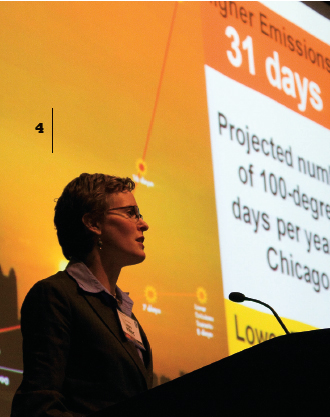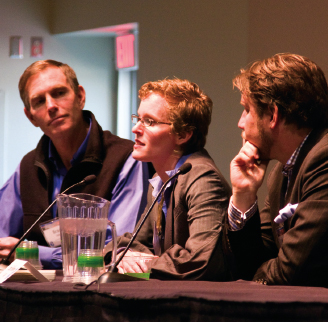City by city
UCAR members ponder urban and regional approaches to climate change adaptation
Jan 15, 2010 - by Staff
Jan 15, 2010 - by Staff
3 December 2009 • Years before Congress began debating greenhouse-gas reduction, urban areas were taking action. More than 500 U.S. cities had pledged by 2007 to reduce their carbon footprints in line with the goals of the Kyoto Protocol, even though the United States as a whole never ratified the treaty.
 Joyce Coffee (City of Chicago) discussed 21st-century temperature projections at the UCAR members meeting. "Climate change action starts with cities," said Coffee. (Photo by Bob Henson.)
Joyce Coffee (City of Chicago) discussed 21st-century temperature projections at the UCAR members meeting. "Climate change action starts with cities," said Coffee. (Photo by Bob Henson.)
American cities are now stepping forth once more, this time on adapting to climate change. Emission reduction remains a high priority, but a growing number of cities are bringing in experts to help them craft responses to a threat that has myriad potential angles.
"There's nothing in the city that won't be affected," says New York's Adam Freed, deputy director of the Office of Long-Term Planning and Sustainability under NYC mayor Michael Bloomberg. Freed was one of several panelists at the annual meeting of UCAR members, held 13-14 October in Boulder. More than 80 member representatives and 27 guest faculty joined the discussion, which was a follow-up to last year's forum on adaptation.
UCAR began the series of community climate adaptation conversations with the development of guidance for the incoming 2009 presidential administration on how to make our country more resilient to severe weather and climate change. The involvement will continue with UCAR helping to organize a national climate adaptation summit for the White House.
This year the emphasis was on how universities and partnerships can help states and cities make the best use of adaptation funding that may emerge if Congress passes a cap-and-trade emissions bill. Panelists and attendees also discussed how best to train a new generation of adaptation-savvy scientists.
Keynote speaker Shere Abbott, associate director for environment in the White House Office of Science and Technology Policy, gave a brief history of federal climate-change policy and relevant reports from the National Research Council. "Our challenge is moving all of these academy reports into action," said Abbott.
That task will get a boost from a new interagency working group focused on climate change adaptation cochaired by Abbott, NOAA director Jane Lubchenco, and Nancy Sutley, chair of the White House Council on Environmental Quality. The new working group will draw on the U.S. Global Change Research Program's recent capstone report, Global Climate Change Impacts in the United States, as well as a new U.S. national assessment on climate change proposed for the 2010s.
Adaptation work has accelerated over the last year in New York, said Freed, expanding from an initial focus on buildings and infrastructure to address a range of other issues. The city is one of the world's first to establish an adaptation task force that goes beyond municipal agencies to include private-sector members as well as state, regional, and federal representatives.
Freed said that it was an uphill battle to fight misleading impressions of climate change acquired from sources such as the lurid disaster film The Day After Tomorrow, in which Manhattan drowns and then freezes within days. Climate "resiliency" is the term Freed favors: it's less value-laden to some ears, and it makes sense regardless of how the atmosphere evolves. Still, Freed is not sanguine about the long-term climate projections, which include three to four times more days over 90°F (32°C) by the 2080s. "By the end of the century, we're going to look a lot more like North Carolina or Georgia than New York," he said. The city is also preparing for a possible high-end sea level rise of 2 meters (6.6 feet) by 2100.
 Presenting their perspectives on local and regional adaptation to climate change were Bradley Udall (Western Water Assessment), Joyce Coffee (City of Chicago), and Adam Freed (City of New York).
Presenting their perspectives on local and regional adaptation to climate change were Bradley Udall (Western Water Assessment), Joyce Coffee (City of Chicago), and Adam Freed (City of New York).
Joining Freed on the UCAR panel was Joyce Coffee, director of project development for the City of Chicago's environment department. In the last two years, Chicago has made impressive strides, said Coffee. These include some 12,000 home retrofits to improve energy efficiency, a 5% increase in mass transit usage, and a new mandate for more than a million square feet of plant-packed green roofs.
Heat is a major concern in Chicago, where a 1995 heat wave killed hundreds. The city could experience 8 to 31 days over 100°F (38°C) per year toward the end of this century. Among other concerns, Chicago is grappling with an increase in pavement potholes, which may be related to winter weather hovering close to the freezing point rather than well below it. Chicago has also mounted a major campaign to reduce basement flooding-already a perennial problem-in anticipation of increasingly heavy downpours.
Water looms large on the regional level too, as noted by Bradley Udall, director of Western Water Assessment, one of seven NOAA-funded Regional Integrated Science and Assessments (RISA) programs. According to Udall, 84% of the Colorado Basin's runoff comes from areas above 9,000 feet (2,700 meters) in elevation, but the topography in most regional models omits that altitude range entirely. "If we're not modeling this right-and we're not-we're not going to get the right answer," Udall said. His RISA is encouraging a diverse set of stakeholders to work with researchers on generating the kinds of adaptation guidance most useful to them.
On a second panel oriented around research, NCAR's Gregory Holland touched on several new approaches to regional weather and climate prediction being explored with university colleagues. At the heart of this future, he stressed, is the need to incorporate ever-expanding observations into models. "Data assimilation will become the single biggest thing we do for climate," said Holland. Richard Rood (University of Michigan) discussed how "federated centers of activity" could pull together people from all walks of research, education, government, and industry, using open-source models to foster innovation. Holland and Rood were joined by Jose Maliekal (College at Brockport, State University of New York) and NCAR's Judith Berner.
Where to find out more
Each presentation's PowerPoint file is posted on the meeting's follow-up site (www.ucar.edu/governance/meetings/oct09/followup), along with roundup reports from UCAR, NCAR, UCP, NSF, the Academic Affiliates Program, and the President's Advisory Committee on University Relations. Also online are presentations from the 2008 UCAR Forum on resiliency to weather and climate and the "transition document" prepared for the incoming Obama administration.
New to the table: UCAR's latest members
UCAR's membership grew to 75 in October with the approval of the latest two member institutions, George Mason University and the University of Maine. Two new academic affiliates, approved earlier this summer, were also announced: Coastal Carolina University and Western Illinois University. For a list of trustees and committee members elected at the October meetings, see the follow-up website.